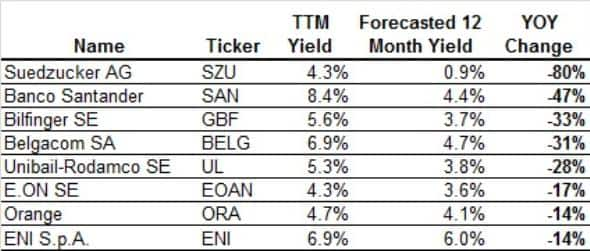Customer Logins
Obtain the data you need to make the most informed decisions by accessing our extensive portfolio of information, analytics, and expertise. Sign in to the product or service center of your choice.
Customer Logins
EQUITIES COMMENTARY
Mar 26, 2015
European ETFs subject to yield trap

Dividend ETFs have surged in popularity but are they leading investors into a yield trap given their reliance on historical dividend yields?
- European listed dividend ETFs now manage a record $12.5bn
- Half the constituents of the largest Euro dividend ETF are expected to cut or hold dividends
- German Suedzucker is forecast to cut dividend by 80%
Dividend ETFs are one of the key success stories of the relatively new investment product. Since their genesis in 2003 these products, which invest in companies with high yielding shares, have seen AUM grow to over $125bn. This makes the 216 dividend products currently listed by far the most popular subset of the $160bn strategy ETF landscape.
European investors, whose ETF adoption has trailed the US market, have flocked to the asset class over the last three years, with AUM having tripled to $12.6bn.
However recent upheavals in some of the historically strong dividend paying sectors, such as energy and telecoms, could leave investors who have piled into dividend ETFs disappointed. This is because almost all dividend ETFs rely on trailing dividend yields as the factor for selecting the highest yielding stocks.
Constituents set to cut payouts
A closer look at the current constituents of the most popular dividend ETF sees that this reliance on backward looking indicators can "trap" investors as many of the companies with high trailing dividend yields eventually end up or freezing cutting pay-outs. This leads to forward yields not keeping up with high backwards looking figures.
Constituents of the iShares Euro Dividend UCITS ETF which is benchmarked against the EURO STOXX Select Dividend 30 index exhibit such a trend. Index rules do look to select high quality dividend payers by screening out potential constituents which have cut payments in the previous five years and those whose payout ratio is greater than 60%. However, the turmoil afflicting the energy sector has resulted in half the index's constituents (by weight) being set to either cut or hold payments flat from last year's number.
To this end, the index has a weighted trailing 12 month dividend yield of 4.4%, but the forward yield comes in at a 4% according to the latest forecast by Markit's dividend forecasting team.
The same list of constituents experienced the phenomenon of a trailing to forward dividend gap last year, but the trend was much less prominent with a gap of less than 0.1% between the trailing dividend yield and the number that was ultimately paid out to investors.
The constituent firm forecasted to cut its dividend payments the most from last year's total is sugar firm, Suedzucker which is expected to pay EUR 0.1 per share in the coming 12 months. This is 80% lower than the EUR 0.5 it returned to investors in the previous 12 months. This cut will see the firm's yield fall from 4.3% to 0.9%.

While this is an extreme example, eight of the index's constituents are expected to cut dividend payments in the coming 12 months with Italian energy firm ENI and telecom firms Orange and Belgacom among them. Belgacom, the largest constituent of the index, is set to cut its payment by a third in the coming year.
Investors should pay attention to dividend forecasts and form their views about the dividend prospects for the constituents stocks within the crop of European dividend ETFs.
Simon Colvin | Research Analyst, Markit
Tel: +44 207 264 7614
simon.colvin@markit.com
S&P Global provides industry-leading data, software and technology platforms and managed services to tackle some of the most difficult challenges in financial markets. We help our customers better understand complicated markets, reduce risk, operate more efficiently and comply with financial regulation.
This article was published by S&P Global Market Intelligence and not by S&P Global Ratings, which is a separately managed division of S&P Global.
{"items" : [
{"name":"share","enabled":true,"desc":"<strong>Share</strong>","mobdesc":"Share","options":[ {"name":"facebook","url":"https://www.facebook.com/sharer.php?u=http%3a%2f%2fstage.www.spglobal.com%2fmarketintelligence%2fen%2fmi%2fresearch-analysis%2f26032015-Equities-European-ETFs-subject-to-yield-trap.html","enabled":true},{"name":"twitter","url":"https://twitter.com/intent/tweet?url=http%3a%2f%2fstage.www.spglobal.com%2fmarketintelligence%2fen%2fmi%2fresearch-analysis%2f26032015-Equities-European-ETFs-subject-to-yield-trap.html&text=European+ETFs+subject+to+yield+trap","enabled":true},{"name":"linkedin","url":"https://www.linkedin.com/sharing/share-offsite/?url=http%3a%2f%2fstage.www.spglobal.com%2fmarketintelligence%2fen%2fmi%2fresearch-analysis%2f26032015-Equities-European-ETFs-subject-to-yield-trap.html","enabled":true},{"name":"email","url":"?subject=European ETFs subject to yield trap&body=http%3a%2f%2fstage.www.spglobal.com%2fmarketintelligence%2fen%2fmi%2fresearch-analysis%2f26032015-Equities-European-ETFs-subject-to-yield-trap.html","enabled":true},{"name":"whatsapp","url":"https://api.whatsapp.com/send?text=European+ETFs+subject+to+yield+trap http%3a%2f%2fstage.www.spglobal.com%2fmarketintelligence%2fen%2fmi%2fresearch-analysis%2f26032015-Equities-European-ETFs-subject-to-yield-trap.html","enabled":true}]}, {"name":"rtt","enabled":true,"mobdesc":"Top"}
]}




